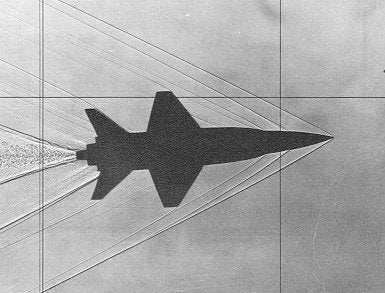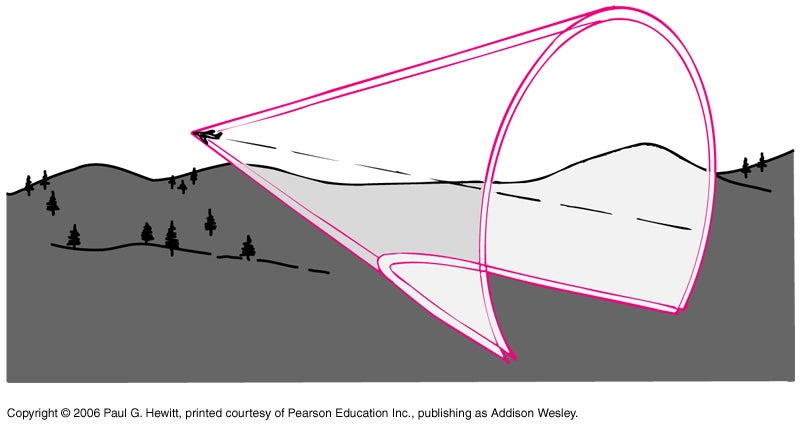 "Jayhawk Jake" (jayhawkjake)
"Jayhawk Jake" (jayhawkjake)
01/30/2016 at 14:39 ē Filed to: None
 17
17
 15
15
 "Jayhawk Jake" (jayhawkjake)
"Jayhawk Jake" (jayhawkjake)
01/30/2016 at 14:39 ē Filed to: None |  17 17
|  15 15 |
Recently !!!error: Indecipherable SUB-paragraph formatting!!! of two Brazilian jets shattering windows with their sonic booms. But what exactly is a sonic boom? This post will hopefully help explain it.
Sound
To understand a sonic boom, first we need to understand sound. What
exactly is sound? In the physics world itís quite simple: sound is the propagation of energy in a medium. This medium can be a solid, liquid, or gas: anything with matter can transmit sound. The propagation of energy shows itself as a vibration. Sound
does not
transmit in a vacuum: thereís nothing to vibrate.
So what is the speed of sound? Unlike the speed of light, the speed of sound is not a constant: it depends on the pressure and density of the medium. The denser the medium the faster sound travels. The closer together the particles of a medium are the faster they transmit vibration to one another. Simple, right?
Because of the relationship between pressure and density in air, the speed of sound in air is really only a function of airís density, and that density changes with temperature. The often quoted 767 mph speed of sound in air is an assumption: it assumes sea level pressure and a temperature of 68 degrees F. If itís colder, sound travels more slowly. This means at higher altitudes the speed of sound is lower than at low altitudes.
Because of the non-constant nature of the speed of sound, in the aerospace world we have a unit that depends on the speed of sound: Mach. Mach 1 is equal to the speed of sound, whatever it happens to be at the temperature it is measured.
To summarize this section: Sound is propagation of energy in a medium. Thatís the important thing to remember for the rest of this article.
Shock waves
Letís picture an airplane moving slower than the speed of sound. As it moves it creates a disturbance in the air. This disturbance emanates from the airplane as fast as it can through the air: at the speed of sound!
As this disturbance travels away from the airplane ahead of it the air particles are essentially alerted that something is coming. The neighboring particles tell each other Ďhey, an airplane is coming! You better get out of the way!í through vibration. You can see this in flow visualization: notice how the streamlines move away from the airfoil as they approach it.

So what happens when youíre moving faster than the speed of sound?
Thereís no warning anymore. The airplane is moving faster than the energy propagation can. The air wants to move out of the way but it canít move fast enough. Itís Ďshockedí into moving, but it has nowhere to go: a high pressure front is created of particles stacking on each other. This is a shockwave.
I could talk about shockwaves all day, but this post is about the sonic boom. For this post, weíll talk only about airplanes traveling entirely supersonic creating oblique shockwaves. We can actually view shockwaves using special imaging techniques, like this schleirin photograph of an x-15 model

Sonic Boom
To recap: sound is the propagation of energy through a medium. When an airplane (or car or rocket or anything) travels faster than the speed of sound, the energy canít propagate forward. Particles in the medium stack up and create a shockwave, which is a very high pressure front.
But what is the boom? Is it the sound barrier breaking?
No. Okay, a little history lesson about the term ĎSound Barrierí. Remember how a shockwave is a high pressure front? Itís a very abrupt change in pressure. This causes all kinds of problems for conventional airplanes. Before scientists truly understood supersonic airflow high speed aircraft were experimented with. Pilots tried to go faster than sound, but it seemed that every time they got close they couldnít do it, or worse: their airplane broke apart and they were killed. This is actually a result of the transonic drag rise which really needs an article of its own. For our purposes just know this: a conventionally designed airplane sees a lot of drag as it approaches Mach 1, so much drag that conventional engines couldnít push it any faster and conventional structure would fail. At the time (right after WWII) some people thought it was impossible to fly faster than the speed of sound, that the speed of sound was an impassable barrier. Spoiler alert: it isnít.
The sound barrier isnít a physical thing, but shockwaves are. When a shockwave is created itís violent, and it travels from the airplane all the way to the ground. Itís from sound, after all, and you can hear airplanes on the ground when they fly over.
This picture is what a shockwave looks like in 3D space

Itís a cone, and the outer surface of the cone is a shockwave. That boom you hear? Itís the shockwave passing you on the ground.
Thatís it! Seriously, itís that simple. Nothing is breaking, itís just a shock. The sudden increase in pressure manifests itself as a loud sound: a boom.
Why are there two booms? Thereís more than one shockwave on an airplane. I will talk to supersonic aircraft design in another article, itís complex and fascinating.
Remember, the shockwave travels with the plane. If you had the power of teleportation and the Shuttle was passing overhead you could wait for a sonic boom, the teleport a few miles in the direction itís traveling and hear it again. Itís not an explosion, it doesnít Ďhappení when the aircraft passes mach 1: itís a constant sound being made as the airplane travels faster than Mach 1. To a ground observer it is only observed as it passes.
So thatís it. A Sonic boom is simply the sound of a shockwave passing you.
If you enjoyed this article, let me know. Iíd love to do another one talking about designing an airplane for supersonic flight. Thatís the real exciting stuff.
 DrJohannVegas
> Jayhawk Jake
DrJohannVegas
> Jayhawk Jake
01/30/2016 at 14:41 |
|
Uhhhhh. No. This is a sonic boom:
Good post, btw.
 WilliamsSW
> Jayhawk Jake
WilliamsSW
> Jayhawk Jake
01/30/2016 at 14:48 |
|
Good stuff, thanks! Looking forward to more!
 Levitas
> Jayhawk Jake
Levitas
> Jayhawk Jake
01/30/2016 at 14:57 |
|
As a fellow aero engineer, this was a very well written, informative article. Well done!
 ttyymmnn
> Jayhawk Jake
ttyymmnn
> Jayhawk Jake
01/30/2016 at 15:01 |
|
Nice job. That shockwave 3D illustration is excellent.
 ttyymmnn
> Jayhawk Jake
ttyymmnn
> Jayhawk Jake
01/30/2016 at 15:03 |
|
For your next essay, please explain the area rule in 300 words or less.
 DrScientist
> Jayhawk Jake
DrScientist
> Jayhawk Jake
01/30/2016 at 15:05 |
|
i enjoyed this article. thanks!
a former coworker asked me this exact question just this past thursday. of course it took me the better part of the night and 5 whiskeys to get through the explanation. but aero-physics is not my corner of science.
 BaconSandwich is tasty.
> Jayhawk Jake
BaconSandwich is tasty.
> Jayhawk Jake
01/30/2016 at 15:33 |
|
And to think that in high school, Iíd never see conic sections again. :P
As someone mentioned, the area rule would be neat to learn about.
 Jayhawk Jake
> ttyymmnn
Jayhawk Jake
> ttyymmnn
01/30/2016 at 16:09 |
|
Thatíll be the next one.
Put simply though: air needs time to react and move around stuff. If the cross sectional area changes abruptly, air has to change its direction abruptly. If you're going really fast, air doesn't have enough time to change direction and a shock forms. Lots of drag is created, airplane can't go as fast.
 SoftRoader
> Jayhawk Jake
SoftRoader
> Jayhawk Jake
01/30/2016 at 16:27 |
|
Temperature and pressure both impact the speed of sound but for two different reasons. Lower temperature means that the particles in the air are vibrating more slowly. Lower pressure means that there is a less particles per given volume. The start of your article is not clear on this. Low temperature does not equal low pressure for example.
 Jayhawk Jake
> SoftRoader
Jayhawk Jake
> SoftRoader
01/30/2016 at 17:55 |
|
Sure. I didnít want to get bogged down in the details, practically speaking in the aerospace realm we treat the speed of sound as a function of temperature when talking about earthís atmosphere.
 Jayhawk Jake
> BaconSandwich is tasty.
Jayhawk Jake
> BaconSandwich is tasty.
01/30/2016 at 17:56 |
|
I gave ttymnn a basic explanation, but Iíll do a detailed article about it.
 MrDakka
> Jayhawk Jake
MrDakka
> Jayhawk Jake
01/30/2016 at 18:21 |
|
Dat oblique shock doe...schlieren photos are always good
 SoftRoader
> Jayhawk Jake
SoftRoader
> Jayhawk Jake
01/31/2016 at 00:26 |
|
I almost wasnít going to nitpick. Great article.
 Barton Stink
> Jayhawk Jake
Barton Stink
> Jayhawk Jake
02/04/2016 at 08:49 |
|
OH you think youíre SOOO smart, donít you? Using all these big science words and like, trying to confuse me into believing in the magic of magnets. Youíre a wizard from the 6th Dimension who is also probably the Debble, aaaaand; Gawd-uh is very displeased with your display of focused intellectual genius. You should probably bring a live chicken to Serrano so he can get Jobu on your side in this.

 Supercharged-V8-Jag
> Jayhawk Jake
Supercharged-V8-Jag
> Jayhawk Jake
02/11/2016 at 23:16 |
|
Nice write up!